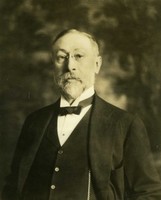Convenience and efficiency
Convenience was a defining feature that Martin exemplified in his hotels and that embodied an important concept in New York City hotels during the Progressive Era. Entrepreneur, George Boldt, the manager of the Waldorf Astoria, cleverly thought beyond the conventional hotel design, and created a complex but profitable plan that resembled Martin’s strategies for the New Vanderlyn and The Dressler. In an article describing the history of the Waldorf Astoria, K.C. Tessendorf described Boldt’s critical observation: “Designed to be renowned for its public rooms as well as its luxurious lodgings, the Waldorf could not turn a profit unless its clientele spent money on food and entertainment as well as a room”. The city had an increasing abundance of people and service options, and bringing these concepts to the comforts of resident’s hotels significantly increased revenue. Martin explained his perception of the concept, “The idea was to lure customers in by means of skillfully arranged display windows and then to persuade them that they never had to leave, since everything they desired was immediately at hand” (181). Although Martin was referencing a department store, his intuition was the same as Boldt’s. Skillfully arranged display windows were luxurious designed hotel rooms and food and entertainment were the convenient persuading features. Martin’s fictional insight further defined how incredible Boldt’s ideas were.
Convenience in hotels had to be assimilated in a cohesive yet valuable way and Martin’s fictional character’s achievement in integrating these complicated aspects reinforced how Progressive Era hoteliers revolutionized the hospitality industry. The Scientific American Periodical described Boldt’s design:
He believes when a guest first enters the hotel he should be able to find within its walls every pleasure and convenience of Metropolitan life. Hence the Astoria contains a grand ballroom, a theatre, a banqueting hall, a full suite of rooms for wedding celebrations, lecture rooms, clubrooms for wedding celebrations, and even a hall furnished specially for meetings of secret societies. (Construction of the Astoria Hotel, New York City)
The ongoing list and range of features included in this quote emphasized the incredible attention to detail that the entrepreneurs put into creating the perfect integrated system. It was unheard of to combine these features prior to the entrepreneur’s creations in the late 1800s to early 1900s. However, Martin defined the appeal to this complexity as he described a scene from the New Vanderlyn:
In the open doors leading to softly lit reading rooms or private lounges, always there was an invitation to put oneself at ease, to escape from the harshness of the world into a pleasant haven that was itself a little world, which carefully controlled excitements of its own. People came in from the street, to buy a cigar or newspaper… perhaps to have lunch in the public restaurant or get a haircut at the Vanderlyn Bazar. (195)
Each of these features and services allowed customers to escape from the chaotic city life and retrieve all of their needs within the hotel. The hoteliers understood how to capitalize on such an expansive time and their pioneering innovations characterized the way hotels are designed today.
The entrepreneur’s brilliant ability to integrate all different aspects of the city that encouraged people to spend more time and money in the hotel was innovatively ground breaking. Arthur Saltzman in A Wilderness of Size: Steven Millhauser’s ‘Martin Dressler’ emphasized how exceptional their creations were through Martin’s character:
A prodigy of commerce gifted with a dependable fiscal instinct, a sixth sense for customer temperament, and a talent for concentrated attention to detail, Martin recognizes that the turn-of-the century New York is the epicenter of something “immense and extravagant [that] was rushing away in every direction,” and the centrifugal sensation inspires instead of unnerves him. (593)
Martin and the Progressive Era entrepreneurs were inspired by the dynamic growth of New York City instead of being intimidated by it. Saltzman’s description of Martin’s fictional character perfectly embodied what made real hoteliers successful. They had a forward looking business sense, understood customer’s needs and had exceptional attention to detail. The establishments that they created were so extravagant that Millhauser used Martin’s dreamlike character to portray their extraordinary abilities.

